Posted by Jacob Huseby on Nov 13th 2020
Skin Skis | Everything you need to know 2021
Everything you need to know about skin skis. Two questions, two answers. Part 1: Why you should buy skin skies over traditional waxless skis. Part 2: How to take care of your skin skis.
Part 1:
Scales or Skins?
Dear Skipost, looking to get me some new skis, traditional/classic, should I get ones with scales or skins on the bottom. I'm not a wax master, LOL!
Thanks, D
Hi D,new skis are always exciting! To answer your question, I would say there are very few cases where someone should choose a scale-pattern ski over a skin ski. I think you will be pleasantly surprised with the advances in skin ski technology that have come out for Nordic skiing in the past 10 years. Skin skis are often made with Angora Goat hairs, nylon, or some mix of the two to create the feeling of having fresh kick wax on your skis.
I encourage you to go to your local shop and feel the skins on the bottom the skis. You'll notice that they are smooth in one direction, and grippy in the other direction. Skin skis are a vast improvement upon the previous generations of "no-wax" classic skis as they not only glide superbly in track, but have similar feel to kicking with wax so you'll feel right at home if you decide to switch over to kick waxes.

While many skin skis are marketed towards the performance crowd, there are also plenty of options for recreational skiers. Skins that are designed for rec skiers have an even more forgiving kick than the race-variant builds of the skis. Skins offer further benefits for recreational skiing by being low maintenance and only require applications of skin-gliding liquid if skiing in colder, wetter conditions to prevent freezing. Otherwise, all you must do is maintain the gliding zones (as you would do on any ski).
Cheers,
Jacob Huseby
(keep reading for part 2)

Part 2
Skin care from Start... to finish.
Dear Skipost, I just purchased a pair of the Fischer Twin Skin Carbon skis, I’m liking them; waxless skis have come a long way in weight and performance and are now being made by all the major ski companies and I notice there are many types of sprays and treatments for the skins, I’ve also seen videos of wax being applied to skins. Couple of questions:
Are all the skin ski areas made of the same material and can you apply any skin ski treatment made by the different companies to them?
Can hard waxes be applied to the skins and best way to do this? What waxes how to apply them?
I’ve heard not to use LF or HF waxes as it can ruin the glue in the skin material, true?
I guess I’m looking for a definitive guideline on waxing do’s and don’ts that help improve the grip and glide of my skins in various conditions, especially wet or cold snow; or is it just marketing hype to sell their products.
Thanks, F
Hi F, here is everything you need to know about skin ski care from Start… to finish:
You will typically find two types of skin on Nordic skis. Most companies use Angora Goat hairs or mohairs as they are commonly referred to, except for Salomon. They use a synthetic Pomoca skin on their performance skis, which is a fun fuscia color. Each company usually has 1 type of skin for their performance skis, and 1 type of skin for their recreational skis. The main difference between performance skins and recreational skins is the balance between kick and glide. Recreational skins are easier to kick, performance skins glide faster. For the sake of argument, we can assume that every skin will benefit from the same kind of treatment as every treatment seeks the same goal. The purpose of skin treatment is to prevent the skins from icing up. Icing is the main cause for a drop in performance of your skins. I’ll give a brief description of the different methods to prevent icing after some background information.
First, I’ll address your point about applying paraffin and hot waxing skins. Hot waxing Nordic skins will not only make your skins lose kick but may detach the skin from the ski. If you’re YouTube savvy, you will notice nearly every video of people hot waxing skins are doing so on alpine skins that are a fuscia color. This is not just a coincidence as these skins are all synthetic skins which would necessitate the application of paraffin by hot waxing. As I have stated previously, most Nordic skis do not have synthetic mohairs except for our friends at Salomon for their performance skin ski. Despite this, I would still avoid hot waxing the synthetic skins found on Salomon Nordic skis due to the risk of weakening the adhesive holding the skin to the ski! It is worth noting that the recommended way to remove a skin from a Nordic ski is typically to apply heat to the skin to weaken the adhesive. 2020 update: Salomon is now using regular mohair skins instead of the Pomoca skins.
Second, there is absolutely no way fluorine found in ski wax product would negatively affect the glue that holds a skin to the ski. The person who told this story may have ruined their skin material while applying a paraffin wax to their skin and blamed the fluorine. The heat of the iron weakened the glue holding the skin in place and it likely came off while trying to kick. The only chemical solvent found in ski wax product that may disrupt the glue on a skin ski would be a harsh wax remover, but some companies even recommend applying wax remover to the skin, so my fear for applying wax remover may be unfounded. While you’re on YouTube, check out this video from Madshus on how to remove a skin. They’re using a heat gun, but your friends iron likely did the trick for their skis.
Okay, now that you are a skin expert, let’s talk about caring for your skins. Skin skis will lose their kick in cold conditions, wet snow, and will lose their glide when in loose deep snow. This is because the hairs on the bottom of the ski cannot grab the snow when there is a layer of ice in the way. Icing also means that a layer of ice is constantly dragging on the snow, killing your glide. Fortunately, products designed for caring for skin skis not only prevent icing in cold or wet conditions but will improve glide in other conditions while maintaining solid kick. Here is a quick rundown of 2 products that will prevent icing and maintain glide.

Good: Start Skinglide paste and cleaner. This will keep your skins ice free down to 16F. You can keep it in your thermo belt and apply it if you find your skins are not gliding as well. It uses a sponge applicator, like our liquid wax gliders and liquid finishers. Simply rub down the skin from tip to tail while the sponge is saturated. This also does double-duty by being a skin cleaner so you can apply it after you ski to clean the skin. This is a great all in one solution for maintaining your skins.
Best: For world cup performance on your skins, a quick spray of RG Ultra Finish Spray will help your skins repel water to prevent icing, and stay clean for the duration of your race. This uses our new techno ceramic additive to create a hydrophobic film on the surface of your skins, allowing you to glide faster with no loss in kick. And again, like last years article, this will help you win the world cup (or beat your buddies in your local 10k).
Honorable mention: Start Skin glide wipes are not only convenient but effective. In a pinch, you can use the sachet from tip to tail for improved glide.
Jacob Huseby, Start Ski Wax
Read the original newsletters for these posts here, and here. This is an updated version of our post from a year ago with new information regarding Salomon skins, and solutions for skin maintenance.


